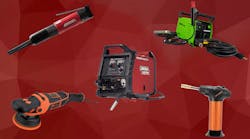“We’re all in the collision business,” says Tim Morgan, managing director of collision repair equipment company Spanesi Americas. He notes that this phrase continues to gain momentum in the vehicle repair market, as the shift continues toward an increasingly sensor-driven vehicle.
At this year’s ETI ToolTech Conference, a particular focus was placed on collision repair. Two items were brought up frequently throughout the three-day conference: the need for proper training in body shops, and the need for proper tooling in body shops, due to the increasingly complex vehicle systems showing up for repairs.
Take the late-model Mercedes-Benz S-Class and E-Class lines, for example. Each vehicle has more than 25 sensors on the front of the vehicle alone which account for a number of advanced driver assistance systems. Even in the event of a minor impact collision, several of these sensors can shift, disconnect or be destroyed.
Previously when a vehicle showed up at a collision repair shop, a visual inspection usually provided enough information to determine an estimated cost of repair for that vehicle. Now, the industry has begun to encourage a standardized approach of these vehicles coming into the shop, beginning and ending with a scan of the vehicle. This is the only way to get a true understanding of the necessary work involved for the repair (read Collision Repair Diagnostics beginning on page xx for more information on this topic).
A shift in the industry will continue, and collaboration with OEs and tool manufacturers is necessary to provide safety and accurate diagnosis for these vehicles, since 70 percent of repairs are done via an aftermarket collision repair facility.
TRENDS
Also at ETI ToolTech 2016, there were a number of collision repair trends discussed, including:
- The shift in understanding the repair process in the body shop. Every body shop is going to require some type of mechanical repair due to the amount of computer-driven components in the vehicle.
- Vehicles are totaling for less severe accidents due to the value and placement of sensors. Even with minor collisions, estimates for damage and repair will increase significantly due to the additional sensors and component placement on vehicles.
- An adaptation to changes in vehicle technology regarding body make-up and mixed materials that must be replaced instead of repaired (e.g. steel structure with aluminum). Turn to page xx for more on this subject.
- No longer are body shops just welding because of the materials on newer vehicles. Other processes now implemented include glues, rivets or screws.
There are also standard methods that collision repair shops continue to practice regarding paint and surface preparation once a vehicle is being repaired (page xx), not to mention the considerations of health and safety for workers on the job (page xx).
As this shift continues toward a more technologically advanced vehicle, what does this mean for collision repair? Currently for independent repair and service shops throughout the U.S. that focus on mechanical work, these businesses tend to focus on specific makes and models of vehicles. Will the shift continue on the collision repair side, with shops specializing in certain makes/models or collision diagnosis?
This special supplement is intended to provide current information and insight into the vehicle collision repair industry. It covers cutting-edge body shop tools and equipment, contributions from I-CAR (Inter-Industry Conference on Auto Collision Repair), proper surface preparation for painting and best practices for preventing illnesses and injuries to collision repair workers.

